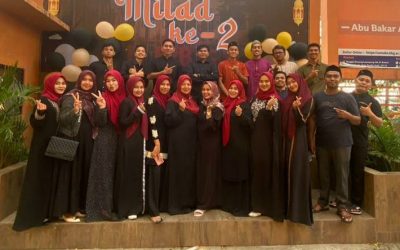
Kasab is a traditional embroidery craft with gold or silver thread in the Aceh region, often referred to as “Kasab Aceh.” This craft first emerged in the Meuraxa Ulee Lheue subdistrict, originating from a family with Teuku M. Yusuf in Dayah Glumpang Ulee Lheue village in Banda Aceh. According to Leigh (1989), the motifs used in Kasab are typically stylized representations of natural elements, such as leaves, petals, flowers, fruits, or vines, with realist depictions of humans and animals being rarely used to adorn these crafted items. Some motifs are also combined with geometric patterns. This choice of natural motifs is closely linked to the beliefs and Islamic faith of the Acehnese people.
In Kasab, cotton is used to reinforce the gold or silver thread. The stitching patterns vary depending on the specific type of Kasab. For example, the South Aceh coastal Kasab features stitching in a broken brick pattern, while the rattan scale stitching uses cotton thread to strengthen the gold or silver thread. The East Aceh coastal Kasab, on the other hand, is known for its unique texture created by covering cardboard with gold thread. This type of Kasab can be found among the Acehnese and Malay communities in the East Aceh coastal area. The technique involves embroidering gold thread on cardboard, which serves as the core of Kasab to create a distinctive texture. The gold thread is reinforced with regular sewing thread, forming the process for making East Aceh coastal Kasab. The process of creating this type of Kasab differs slightly, starting with stretching the base fabric taut and then arranging the cardboard on top of it.
According to Leigh (1989), there are two traditional types of Acehnese Kasab: first, the South Aceh coastal Kasab, known for its diverse range of motifs. This technique allows for the creation of various desired motifs, as the gold thread used can be applied in different patterns. This type of Kasab is typically found in the South Aceh coastal area and is used by the Aneuk Jamee and Alas ethnic groups. The flat Couching stitching patterns in South Aceh coastal Kasab include regular stitching with cotton thread to reinforce the gold or silver thread, resembling a brick pattern. Other patterns like bungong campli, iris halwa, and liku keris also employ cotton thread for reinforcement and feature various decorative designs.
Kasab fabric is a traditional handcrafted embroidery of gold or silver threads unique to Aceh, traditionally sewn on velvet fabric. Kasab fabric consists of numerous motifs, predominantly floral, embroidered and embellished with gold-colored beads. It is believed that this traditional fabric represents social status, with yellow symbolizing a king, red for royal warriors or leaders, green for religious scholars, and black for commoners.
For the Acehnese people, Kasab goes beyond mere decoration and aesthetics. The patterns in Kasab also symbolize religious devotion deeply intertwined with their culture. Kasab is commonly used in weddings, circumcision ceremonies, aqiqah celebrations, and other customary rituals. It is not limited to curtains but is also seen in other decorations such as wedding thrones, doorways, seat cushions, room ceilings, beds, fans, and keychains. Kasab has now expanded beyond traditional rituals and is used in souvenirs that showcase ethnic charm. The duration of the production process varies depending on the type of item being created, with the price determined by the specific product and the type of thread used. If gold thread is used, the price will naturally be higher.



